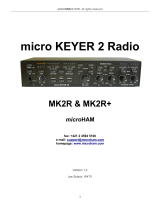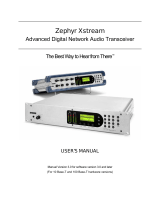Page is loading ...

XStream-PKG-U™
USB RF Modem
• One XStream-PKG-U™ USB RF Modem
• One XStream-PKG-R™ RS-232/485 RF Modem
• Accessories (USB cable, Loopback Adapter, 1 Power Supply, 2 RPSMA Antennas)
Create a long range wireless link in minutes.
Quick Start Guide
To install the modem and test its range, you need:
Connect Hardware
Hardware Setup
1. Verify PKG-U RF Modem ("Radio1") was successfully connected to the USB
port of the PC.
2. Attach serial loopback adapter to the female DB-9 serial connector of the
PKG-R RF Modem (Radio2).
The serial loopback adapter configures Radio2 to function as a repeater
by looping data back into the modem for retransmission.
3. Attach RPSMA antennas to Radio1 & Radio2.
4. Power Radio2 through its power connector. (Radio1 is already powered
through one of the pins of the USB connection)
PC Radio1
PKG-U (USB)
Radio2
PKG-R (RS-232)
(w/ loopback adapter)
USB Cable
Install X-CTU Software
Install Software
• One computer that has an available USB port and is loaded with the following software:
X-CTU software and USB RF Modem drivers.
Go to the X-CTU software page at www.digi.com/xctu and launch the latest X-CTU installer. Follow the
prompts on the installation screens.

LED indication of successful USB link
(Left-bottom Red LED is illuminated.)
PC Settings tab
Com Port dedicated to the
PKG-U RF Modem ”Digi PKG-U (COM#)”
PC com port enumerations can also be viewed through
Device Manager.
Install USB RF Modem Drivers (Hardware USB Bus & Virtual Com Port drivers)
Verify Driver Installations
1. Connect the PKG-U RF Modem "Radio1" to the USB port of a PC.
An illuminated bottom-left red LED indicates a successful USB link.
2. Launch the X-CTU Software: Start > Programs > Digi > X-CTU .
3. Click the PC Settings tab. Under the Com Port Setup section , select the
PKG-U that is connected to the USB port. Com ports dedicated to a USB RF
modem have ”Digi PKG-U” in the com port name. This PC com port will be used
when executing the range test.
Go to www.digi.com/xctu and click the Drivers link. Under General Drivers, select the appropriate
operating system to download drivers.

3
PC Com Port
Default Values
Refer to XStream RF Modem part number
to determine its default RF data rate:
X09-009... = 9600 bps
X09-019... = 19200
X24-009... = 9600
X24-019... = 19200
Remaining Default Values:
Flow Control = NONE
Data Bits = 8
Parity = NONE
Stop Bits = 1
2
RSSI check box
RSSI stands for "Received Signal Strength Indicator".
3
Start/(Stop) button
(Packet Information)
Range Test tab
2
Configure Serial Port-Modem Communications
Configure a serial port to communicate with the modems:
1. Launch X-CTU Software:
Start > Programs > Digi > X-CTU
Click the PC Settings tab. From the dropdown list, select the PC com port that will
be used to connect to Radio1. Com ports dedicated to USB RF Modems always
begin with “Digi PKG-U...”.
Select the Baud rate that matches the default RF data rate (over-the-air baud)
of Radio1. Use default values for remaining fields.
2
3
1. Click the Range Test tab.
(Optional) Check the check box in the RSSI section to enable its display.
Clic the Start button to begin range test.
4. Move Radio2 (with loopback adapter) away from Radio1 and observe packet information
to determine the range of the wireless link.
2
3
PC Seings tab
Determine the RF Modem’s Range

Tips and Suggestions
Phone: (801) 765-9885, Live Chat: www.digi.com/xctu E-mail: [email protected]
Contact Digi (Office hours are 8am – 5pm U.S. mountain standard time)
Wireless Link between Devices
Create a Wireless Link between Devices
Modify Interface Data Rate
(Optional)
Modify Interface Data Rate of RF Modem
(Optional)
Host PC
Radio1
PKG-U (USB)
Radio2
PKG-R (RS-232)
USB cable
Target
Serial
Device
RPSMA antennas
male-to-male
NULL modem adapter
serial cable
A pair of RF Modems can be used in lieu of a cable to create a wireless link between
devices. The diagram below shows a wireless strategy for connecting to target devices
such as automatic meter readers, fleet management devices, remote weather stations,
and a host of other applications. When connecting devices, consider the following:
• Use the male-to-male NULL modem adapter to connect Radio2 to a
target serial device. Signals crossover inside the adapter.
• To verify cabling is functioning properly, insert a female-to-female
NULL modem adapter in place of Radio1 and Radio2, then test
communications without the RF modems in the link.
1. Set up a connection to a PC by following the installation steps on page 1.
2. Select the PC Com port baud rate that matches the RF Modem's fixed RF data rate by
following steps 1, 2 and 3 of “Configure Serial Port-Modem Communications” (page 3).
3. Click the Modem Configuration tab of the X-CTU Software.
4. Click the Read button to view currently stored parameter values.
5. In the Commands/Parameters hierarchical tree, open the Serial
Interfacing Options folder by selecting its plus (+) sign.
6. Select the Baud Rate entry, then select a desired baud rate from the
dropdown list.
7. Click the Write button to save new settings to non-volatile memory.
8. Select the PC Settings tab, then select the value from the ‘Baud’ dropdown list
that matches the newly set baud rate. This configures the PC com port to
communicate at the new baud rate.
OEMs and integrators can interface with XStream RF Modems at different baud
rates than the modem defaults, though actual RF data rate is fixed. To change the
modem’s serial interfacing rate, first select the PC com port baud rate that matches
the modem’s default [steps 1-2 below]. Then change the baud rate of the modem
itself [steps 3-7]. Finally, select the baud rate of the PC com port to match the
newly set baud rate of the modem [step 8].
© Digi International Inc., 2013.
Digi, Digi International, the Digi logo, and XStream are trademarks or registered trademarks of Digi International, Inc.
in the United States and other countries worldwide.
B
90000820-88
/


